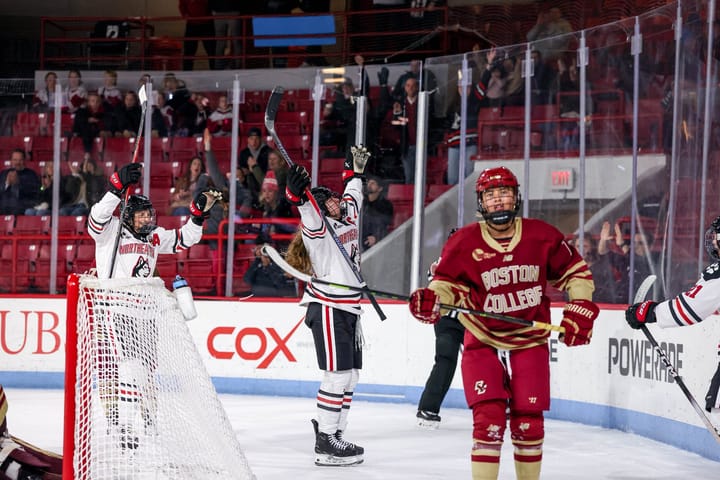Made in Michigan: Why the Univ. of Michigan deserves to go D-I in the NCAA
The state of Michigan has no shortage of women’s hockey talent or hockey fandom — so why doesn’t the state’s largest institution have a D-I program?
The rivalry between the Ohio State University and the University of Michigan is one for the ages — there’s no two ways about it. Between football, men’s hockey, and pretty much every other D-I sport in which the two institutions have teams, there’s no understating the intensity of the competitions.
Where the rivalry is lacking is when it comes to NCAA Division I women’s hockey.
While Ohio State has had a D-I women’s hockey program competing in the WCHA since 1999, the University of Michigan has only had a club team (i.e. a team not officially funded by the school’s athletic department; typically players are required to pay for their own ice time and equipment) despite numerous efforts to make women’s hockey a school-funded varsity sport.
It’s undeniable that Michigan is one of the top producers of women’s hockey players — some of hockey’s top names right now hail from that state up north, including NWHL stars Madison Packer and Tori Sullivan and 2020-21 PWHPA commits Megan Keller and Abby Roque. To say that there’s a shortage of talent in Michigan is just factually incorrect, especially when you consider the success of the Detroit Little Caesars, Belle Tire, and Honeybaked programs — which, again, have produced top tier players like 2020 U18 WWC gold medalists Clara Van Wieren, Amanda Thiele, and Emma Gentry.
Don’t get me wrong, there are plenty of post-secondary opportunities for players looking to continue their academic and playing careers, what with two D-III programs (Adrian College and Finlandia University) and a myriad of club opportunities, including the ACHA D-I squad at Michigan itself. Some of the existing rivalries in Michigan’s conference, the CCWHA, are very fierce as they stand, but there’s also no denying the spark that a D-I program at Michigan could bring to a conference like the WCHA, whose list of rivalries has long since been dominated by the Border Battle.
Related
Best rivalries in the NCAA
Best rivalry in women’s hockey
Speaking of the WCHA, Michigan would be the perfect fit in the NCAA’s westernmost conference. While you might argue that the university is too far east to allow for easy transportation, it’s only a three hour drive to Ohio State — their biggest would-be rival and a team they’d meet around four times in the regular season.
Adding another team to the WCHA would help with the postseason scheduling too. At the moment, the regular season WCHA champion receives a bye to the semifinal round of the conference tournament, which seems great in theory but means that we miss out on a lot of spice in the quarterfinals. With Michigan as the eighth team in the conference, each team could participate in the quarterfinals and send the victors on to the semifinal round, which would make things a lot more exciting and overall a lot more mathematically pleasing.
Basically, I just really want a D-I team at Michigan and will do anything to get one. Can you really blame me?
Anyways, let’s ignore my bias for a second and take a look at some of the talent the state has to offer — talent that could surely buoy a program until it’s established as enough of a powerhouse to attract top college prospects.
ACHA Prospects
I’m gonna start out with some ACHA prospects, because let’s be real — the state of Michigan has a lot of ACHA clubs, and some of the native Michiganders competing at the club level have absolutely blown me out of the water this past season. For the sake of this piece, I’m considering every player who has yet to complete their ACHA eligibility (which, in contrast to the NCAA, is five seasons) as of the end of 2019-20.
Julia Lutz, forward, Michigan State
I don’t even know where to start with Julia Lutz. The native of Livonia, Michigan, ranks just seven points out of the scoring lead in ACHA Division I. Her league leading 27 goals and 15 assists over just 19 games put her in second in points per game, and she’s only in her sophomore season. Lutz spent two years with Honeybaked prior to starting her collegiate playing career, so she’s homegrown all the way around. She was also named an ACHA second team All-American — the first such honor of her career, but certainly not the last.
Taylor Lundberg, forward, Michigan
For the past two seasons, Taylor Lundberg has led the Wolverines’ club team in points by a wide margin: in her freshman season, her 14 goals and 21 points were followed by defender Lia Harrington, who came in at 9 points. She’s been pivotal in re-establishing Michigan’s place in the ACHA, hauling her squad closer and closer to postseason contention each year that she skates. A native of Traverse City, Lundberg played a year of D-III hockey with Colby College in Massachusetts, where she totaled only two points over 19 games. Don’t let her production at the NCAA level fool you — there are a lot of extenuating circumstances that might prevent a player from meshing with teammates or the school environment, so I wouldn’t immediately count Lundberg out based on her performance at Colby.
Bailey Hamill, goaltender, Michigan
Bailey Hamill finished up her fourth of five years of ACHA eligibility at Michigan in 2018-19, and while she didn’t play in 2019-20, it’s safe to assume that, given the opportunity, she would slot right into a D-I roster at Michigan. Her save percentage of .927 in her final season of play was good for seventh league-wide, while her goals against average of 2.47 put her roughly in the middle of the pack of ACHA goaltenders. However, it’s hard to discount her impact on the roster when her team’s goal differential dropped from +24 to -86 in the single season since her departure.
Potential D-I Transfers
Though there are obviously currently no NCAA D-I programs in the state of Michigan, that doesn’t mean there aren’t players born in Michigan playing at any one of the forty-one institutions across the country. Let’s take a look at some of the native Michiganders that could make an impact on a potential Wolverines roster. Again, for the sake of this piece, I’m considering any player at the NCAA D-I level who has yet to finish out their four seasons of eligibility and could hypothetically finish out their career at Michigan if a program were to materialize this offseason.
Emily Curlett, defender, Robert Morris
Emily Curlett will enter her senior season with the Colonials in 2019-20, but if there was a team at the University of Michigan, it’s undeniable that she’d be a sought after piece to build up the Wolverines’ blue line even with only a single season of eligibility remaining. In 2019-20, Curlett totaled 36 points, good not only for a personal record, but for third on the team and first in the CHA among defenders. The native of Lapeer has been named to an all-league team every single year she’s played in the NCAA — first to the all-rookie team as a freshman, then to the all-CHA second team in her second season, and most recently to the all-CHA first team. Should she transfer to the ultra competitive WCHA, there’s no doubt she’d fit right in with high-scoring defenders like Ashton Bell and Jincy Dunne.
GOAAALLL! Curlett dials one up and it is 2-1! pic.twitter.com/H5sz0dCq8X
— RMU Hockey (@RMUWHockey) February 8, 2020
Anna Segedi, forward, St. Lawrence
Anna Segedi has a pretty impressive youth hockey history in Michigan — in 2017, she won a national title with Belle Tire’s U19 program, then earned silver and bronze medals the next two years. She hasn’t slowed down at St. Lawrence, posting 23 points in her freshman campaign, good for second on the team. She was, in our opinion, snubbed by the ECAC in terms of all-league awards this season, but there’s no doubt that Segedi would come out skating just as strong in the WCHA. Segedi ranked in the national Top 20 among NCAA freshmen, so I know you can do the math and calculate just how good of a fit she’d be in maize and blue.
Amanda Thiele, goaltender, Ohio State
Listen, as excited as I am to see Amanda Thiele shine between the pipes for the Buckeyes, can you imagine how intense the rivalry would be if she defected to the Wolverines? Thiele’s on track to be apart of a seriously unstoppable tandem with current Ohio State starter and incoming junior Andrea Brändli, but we already know she’s well-suited to the color blue. She’s got some hardware and a pretty solid stats sheet to back her up — at the 2020 U18 Women’s World Championship, she blanked Russia in the preliminaries and in the semifinals in what would eventually lead to another gold medal for the red, white, and blue. Thiele would be one of my first targets as a netminder in the national team pipeline if I was in charge of building up Michigan’s hypothetical roster.
We see you holding down the fort back there, Amanda Thiele! ✋ #U18WWC pic.twitter.com/xFAlj994te
— USA Hockey (@usahockey) December 27, 2019
As my colleague and friend Gabs Fundaro pointed out, though, it’s not easy to build a program from the ground up — especially not at a school that refuses to subsidize their women’s club hockey team or discount the rate required to rent out the arena. Per the linked article by Neal E. Boudette for The New York Times, as of 2017, Michigan has no plans to add a Division I women’s hockey program to the school’s list of 29 varsity sports (14 men’s teams and 15 women’s teams), despite the overwhelming push by students and players and outside pressure from people who write articles about the university’s talent pool.
Gabs even mentioned to me that bringing a D-I women’s hockey program to Michigan State might be more feasible. The Spartans have had considerably more success at the ACHA D-I level, what with two national titles under their belts, but the allure of a women’s team playing in front of sell-out crowds at Yost Ice Arena has me stuck on Michigan.
Nevertheless, my point stands: bring NCAA D-I hockey to the University of Michigan and you’ll be sure to reap the rewards of a very talented player pool and a built-in rivalry.
All statistics and data courtesy of EliteProspects, HerHockeyCounts, and team and league websites.





Comments ()